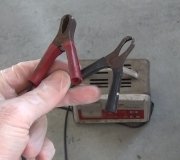Actually, that might be too much. Unless specified differently by the car manufacturer, the industry standard for drain on the battery to keep all the computer memories alive is 35 milliamps, (0.035 amps). Chrysler says at that rate, a good, fully-charged battery will still be able to crank an engine fast enough to start after sitting for three weeks. Many Cadillacs allow up to 50 milliamps. On most cars you'll find the actual draw is much less than 35 milliamps.
The problem with a small trickle charger is they are meant to charge a discharged battery. They really are not meant to just hold one at full charge. When the battery is fully-charged, the trickle charger is still going to be pumping current through it, and that could lead to over-charging and boiling the water out of the battery. That would not be a problem for a month or two, but I ran into this with solar panels on a trailer I take to old car show swap meets. I left two panels charging the batteries all winter, and in the spring they were really low on water. Refilling them will never bring back the capacity in the part of the plates that dried out.
There are three better alternatives. One is to look for a very small "float" charger. Those are designed especially to address the small drain on stored batteries. The second choice would be to look for a small solar panel that sits on top of the dash, and plugs into the cigarette lighter. Those only work if the lighter socket is live all the time. On many cars the ignition switch has to be on. That means that little solar panel would be trying to run the entire electrical system. Look instead for a power outlet. Technically those are different because they do not have the thermal cutout safeguards built in. It is common to find those can be made live all the time by switching the location of the fuse that protects them.
The third choice is to disconnect everything that draws current when the ignition switch is off. That is how they're stored by the manufacturer, and how they are shipped. The dealer is responsible for activating the electrical system as part of the new vehicle prep. On older models from the late 1980's and early 1990's, there was often a bullet connector in a single fat wire attached to the battery's positive cable. Unplugging that still allowed the engine to be started, and the car could be driven, but things like the air bag, radio, heater fan, and some other systems wouldn't work. By the mid 1990's, there was typically one fuse we had to install at the dealership to bring all those systems to life. Now it is more common to find two Airbag fuses in a bright yellow holder that makes pulling them part-way out real easy. The method of disconnect you are looking for is called the I.O.D. Connector or fuse, for "ignition-off draw". That should be listed in the owner's manual, or almost anyone at the dealership can tell you how that was done on your year and model. You can also disconnect the battery's negative cable to do the same thing.
The are more and more models showing up within the last ten years or so that have computers purposely designed to lock up when the battery is disconnected. That warning needs to be mentioned to avoid a very expensive tow to the dealership to have them unlocked. That does not apply to your car because you have already had dead batteries, and you did not mention having any such problems. This is a trick pulled by only a few manufacturers, but it is worth mentioning.
Sunday, November 11th, 2018 AT 11:06 PM



